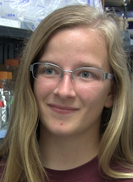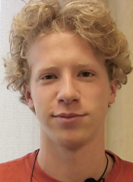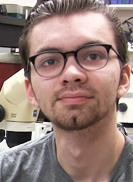2017 Summer Undergraduate Research Participants
Kandis Arlinghaus
Student at Bellarmine University
Mentor: Nicholas Mellen, Ph.D
Project Title: The effects of a zinc and fat controlled diet on BTBR mice
BTBR mice are an inbred mouse model used to study autism. Autism Spectrum Disorder (ASD) is a heterogeneous neurodevelopmental disorder that affects approximately 1 out of every 68 children in the US. Widespread activation of brain immune cells that produce inflammation is a neurological symptom of this poorly understood disorder. Growing data suggests diet can be used to control inflammatory effects in other conditions such as diabetes which is regulated by the anti-inflammatory characteristics of zinc. Our aim is to determine if the lack of zinc’s anti-inflammatory activity would worsen the symptoms associated with autism. 115 mice were separated into 6 groups with varying levels of low, normal, and high zinc and fat based on a 4057 kcal diet. Behavioral analysis was conducted through a two camera recordings of an open field test, a three chamber test, and an elevated plus maze test. Data are in the process of being analyzed.
Close

Morgan Bahnsen
Student at Thomas More College
Mentor: Juhi Bagaitkar, Ph.D.
Project Title: NADPH oxidase-derived ROS regulate TLR2 responses in mouse dendritic cells
The leukocyte NADPH oxidase is a multi-subunit enzyme that generates superoxide (O2-), which is rapidly converted to antimicrobial reactive oxygen species (ROS). Mutations in NADPH oxidase subunit alleles that ablate enzyme function cause chronic granulomatous disease (CGD), an immunodeficiency characterized by life-threatening bacterial or fungal infections, and granulomatous inflammatory complications in the gastro-intestinal and respiratory tracts unrelated to infection. Independent of its role in microbial killing, ROS are essential for immune regulation. An emerging amount of evidence now links hypomorphic NADPH oxidase alleles with enhanced susceptibility for multiple chronic inflammatory and autoimmune disorders. However, a mechanistic understanding of how NADPH oxidase-derived ROS regulate inflammation are still largely lacking. We determined whether NADPH oxidase regulates inflammatory responses downstream of Toll like receptor (TLR) stimulation. Bone marrow-derived dendritic cells (BMDCs) from wild type (WT) or Cybb-/- mice that lack NADPH oxidase function due to deletion of Cybb (codes for gp91phox) were stimulated with TLR2 agonist Pam3CSK4 and inflammatory cytokine expression determined by quantitative PCR (qPCR) and ELISA. BMDCs from Cybb-/- and WT mice had similar surface expression of TLR2 as well as co-stimulatory molecules CD80 and MHC-II. Pam3CSK4 induced TLR2 stimulation strongly activated NADPH oxidase resulting in ROS production in WT BMDCs measured by lucigenin elicited chemiluminescence. Q-PCR analysis showed similar levels of pro-inflammatory cytokine transcripts (TNF-a, IL-1b, IL-1a and IL-6) on TLR2 stimulation within the two genotypes, indicating ROS production does not influence transcriptional responses in BMDCs. However, Cybb-/- BMDCs expressed significantly elevated protein levels of pro-inflammatory cytokineIL-6 (ELISA) compared to WT BMDCs. These data demonstrate hyper-inflammatory responses in Cybb-/- BMDCs are partly driven by overt production of pro-inflammatory cytokines. Future studies will determine redox-regulated signaling proteins and pathways activated by TLR2 that are regulated by NADPH oxidase derived-ROS. Overall our preliminary studies indicate a counterintuitive role for oxidants in modulating host inflammatory responses. These studies are essential for understanding the mechanistic basis underlying hyper-inflammatory complications observed in CGD patients.
Close

Taylor Cash
Student at Morehead State University
Mentor: David Magnuson, Ph.D
Project Title: Can acute exercise reverse cardiac decline after incomplete spinal cord injury and reduced activity housing?
Cardiovascular (CV) dysfunction is one of the most serious secondary complications that accompanies high thoracic and cervical spinal cord injury (SCI), which comprise the vast majority of clinical injuries. Early post-injury, both systemic and orthostatic hypotension plague many patients, interfering with activities of daily living and delaying the initiation of rehabilitation. Over the next weeks or months, many patients experience bouts of autonomic dysreflexia (AD; increased BP and decreased HR) triggered by afferent input due to the imbalance of the autonomic nervous system (ANS) sympathetic /parasympathetic output. For many patients, dealing with AD becomes a life-long battle. As a result, CV disease/dysfunction is the single highest cause of mortality and morbidity for patients with high thoracic or cervical SCIs.
Most patients who experience moderate to severe, but anatomically incomplete injuries spend weeks supine with very low levels of activity. We hypothesize that the severity of CV dysfunction that patients experience chronically is solely dictated not only by the severity and location of their injury, but rather by a combination of the injury parameters and the length of time spent immobile. Thus, the focus of this study is the underlying changes in autonomic CV control that are initiated at the time of injury as a result of immobility/inactivity, and if left to proceed unchecked, ultimately result in the development of these serious complications.
We have developed a model of reduced activity where adult female SD rats are given moderate-severe contusion injures at the T2 spinal level which interrupts descending control of locomotion and sympathetic control of the cardiovascular system. These animals are pair-housed in tiny cages that reduce in-cage activity by more than 60% when compared to standard housing. This reduction in activity mimics the inactivity resulting from being confined to a bed post-injury. To combat the decline in function resulting from reduced activity we used two different exercise strategies, swimming and stepping in shallow water. These exercise paradigms attempt to recreate commonly used clinical rehabilitation strategies. Swimming models arm-only ergometry whereas shallow water stepping is similar to weight supported step training. Our primary outcome measures are echocardiography using a high-resolution ultrasound machine to quantify the structure and function of the heart and major arteries. After sacrifice, we examine the histology of the heart. The hearts are fixed, cryopreserved and cut in cross section on a cryostat. The sections are slide mounted and stained for muscle and collagen using a classical trichrome procedure. Mid-ventricle sections are imaged and left ventricular wall thickness and percent collagen are used as indications of cardiac deconditioning. We anticipate that spinal cord injured animals housed in tiny cages will show significant cardiac decline that will be partly reversed by the exercise regime.
Close

Thomas Case
Student at Alice Lloyd College
Mentor: Silvia M. Uriarte, Ph.D.
Project Title: SOCS 1 role in manipulation of neutrophil signaling by oral pathogen, Filifactor alocis
Periodontitis is a microbial-induced chronic inflammatory disease that affects the gingival tissues supporting the tooth. Although some oral pathogens such as Porphyromonas gingivalis are considered keystone pathogens in the initiation and progression of periodontitis, the application of high-throughput sequencing technologies to the oral microbiota, has resulted in the recognition of several newly appreciated organisms which are associated with periodontal lesions. Among these is the Gram-positive anaerobic rod Filifactor alocis, which is present in high numbers in periodontal disease sites compared to healthy sites. Neutrophils are a major component of the innate host response and contribute to the maintenance of periodontal health by protecting the tissue against bacterial infection. The outcome of the interaction between periodontal bacteria and neutrophils is thus a key determinant of oral health status. The main objective of this project is to determine if F. alocis infection causes upregulation of SOCS 1 to dampen neutrophil signaling and responsiveness. Neutrophils can produce several cytokines and chemokines upon different stimulation. Preliminary data from our laboratory shows a time dependent increase on the mRNA expression of several cytokines and chemokines by F. alocis infection. SOCS1 is a key negative regulator of cytokine production and its role in neutrophils upon bacterial infection is not well characterize. We predict that F. alocis can manipulate neutrophil signaling downstream of Toll-like receptor recognition to control the cells ability to execute key functional responses.
Close

Swetaben Patel
Student at Western Kentucky University
Mentor: Michal Hetman, M.D., Ph.D.
Project Title: Exploring Small Molecule Drugs Binding to Ribosomal Protein L11
The nucleolus is a dense area in the nucleus when a cell is in interphase. One of the main functions of the nucleolus is ribosomal biogenesis. Malfunctions or dysfunction in any step of the production of ribosomes can induce ribosomal stress. Ribosomal stress effects many proteins and can lead to main diseases. In our research, we are directly focused on how ribosomal stress effects ribosomal protein (RP) apaL11 which is an important component of the large ribosomal sub-unit that loads 5S rRNA(Zheng et al., 2015). RPL11 also plays a significant role in regulating growth associated pathways. Ribosomal stress causes RPL11 and ubiquitin ligase MDM2 to interact and cause tumor suppressor p53 activation leading to apoptosis. Through bio computer screening, thirty-five drugs were selected that targeted L11. The drugs selected had the potential to disrupt and promote ribosomal biogenesis. Through testing, it was found that the drugs were quite toxic more than aid in cell survival. Therefore, the top nine cytotoxic drugs showed potential to be used to aid in anticancer therapies and were chosen to be tested on other cancer lines. Afterwards, the drugs’ effect on nuclear morphology was analyzed(Slomnicki et al., 2016).
Close

Carter Waugh
Student at Eastern Kentucky University
Mentor: Ayman El-Baz, PhD
Project Title: An Automatic Segmentation Method for the Thigh Muscles and Adipose Tissue of Spinal Cord Injured Patients
In the event of a spinal cord injury (SCI), individuals are often subject to skeletal muscle deterioration and adipose tissue gain in paralyzed muscles. These negative impacts can limit motor functions and lead to secondary complications. A novel framework was proposed to automatically segment the MRI volumes of human thigh into fat and muscle volumes. Additionally, within the muscle volume, three main muscle compartments: quadriceps femoris, hamstrings and adductors were segmented. The proposed method for fat segmentation has been shown previously to have a high accuracy (95.51۫.61). Further, muscle group segmentation has too been shown to have high accuracy (94.76۫.70). The accuracy measures were based on dice similarity percentage calculated on 10 spinal cord injured (SCI) and 10 non-disabled (ND) individuals.
Close

Kendall Collins
Student at Eastern Kentucky University
Mentor: Ashley Seifert, PhD
Topic: Using Gene Expression to Understand Macrophage's Role in Tissue Regeneration
Research reported in this publication was supported by an Institutional Development Award (IDeA) from the National Institute of General Medical Sciences of the National Institutes of Health under grant number P20GM103436.
Close

Nicole Dzubuk
Student at Western Kentucky University
Mentor: Robin Cooper, PhD
Title: Examining the role of muscarinic acetylcholine receptors in regulation of larval Drosophila melanogaster feeding and locomotion.
Acetylcholine (ACh) is an abundant neurotransmitter found in many species across various taxa. In mammals, it is integral in modulating neural circuits underlying processes such as learning, memory, and reward processing. In Drosophila melanogaster, ACh exhibits comparable importance and is known to influence a number of behaviors, including locomotion and feeding; however, the receptor subtypes through which ACh imparts its modulatory influence in this model is poorly understood. The receptors that facilitate synaptic transmission at cholinergic synapses and beyond are divided into two broad subtypes: the ionotropic nicotinic acetylcholine receptors (nAChRs) and the metabotropic muscarinic acetylcholine receptors (mAChRs). Here, we have utilized combined pharmacological and genetic approaches to assess the role of muscarinic receptors (mAChRs), specifically, in regulating two essential behaviors: locomotion and feeding in larval Drosophila. We have revealed that acute and chronic exposure to a mAChR agonist, muscarine, and receptor antagonist scopolamine, significantly alters both behaviors. Moreover, tissue-specific mAChR knockdown also significantly modifies both locomotion and feeding. The results suggest these receptors play an integral role in mediating ACh regulation of these fundamental behaviors. Additionally, we are currently adding to this knowledge by testing the impact on developmental rates with reduced mAChR expression and developmental exposure to receptor agonists and antagonists.
Funded by Kentucky Science and Engineering Foundation (KSEF-3712-RDE-019) at the Kentucky Science and Technology Corporation (RLC); Institutional Development Award (IDeA) from the National Institute of General Medical Sciences of the National Institutes of Health under grant number P20GM103436 (MM & ND).
Close

Conner Hounshell
Student at Western Kentucky University
Mentor: Jeramiah Smith, PhD
Topic: Real time visualization of DNA elimination in live, unfixed embryos
Unlike most vertebrates, sea lamprey embryos undergo unique changes that re-engineer the physical structure of their genome. These restructuring events (known as programmed genome rearrangements) result in the selective removal of several hundred genes from essentially all somatic cell lineages: they are only retained by the germline. Previous studies have found that this loss of DNA is highly orchestrated and presumably involves changes in the movement of eliminated DNA during anaphase. However, our understanding of the processes of DNA elimination has been reconstructed from snapshots of fixed embryos and the process has never been observed in living embryos. My work seeks to optimize DNA staining, imaging and embryo culture methods that permit the real time visualization of DNA elimination in live, unfixed embryos.
Close

Lee Kendall
Student at Centre College
Mentor: Doug Harrison, PhD
Topic: Genetic analysis of soma-germline communication during spermatid differentiation
Sperm are perhaps the most highly specialized and modified cells in the animal world. They are specifically designed to be efficient couriers of the male’s genetic information. Animal sperm vary in shapes and sizes to carry out this task. Nonetheless, the general process of sperm production is largely similar from insects to mammals. Construction of a sperm is accomplished with the assistance of other cells in the testis. While many studies have uncovered genes that are active in sperm during their development, little is known about the genes and functions of the support cells in the testis. In the fruit fly, Drosophila melanogaster, each 64-spermatid cluster develops as an interconnected cyst and is encapsulated by a pair of somatic support cells, called cyst cells. Recent work in the lab has uncovered that communication between these somatic cyst cells and the spermatids is necessary to direct the separation of spermatids within a cyst during the late stages of spermatogenesis. To better understand the roles of the somatic support cells, this project will identify factors required in cyst cells to complete sperm development. For this project, we will specifically impair the functions of particular candidate genes only in the support cells of the testis to examine the impact on sperm formation. Because the process of spermatogenesis is similar across species, this work will not only aid in understanding cellular collaboration in Drosophila spermatogenesis, but it will contribute to our understanding of spermatogenesis in general.
Close

Megan Medley
Student at Eastern Kentucky University
Mentor: Robin Cooper, PhD
Topic: Examining the role of muscarinic acetylcholine receptors in regulation of larval Drosophila melanogaster feeding and locomotion.
Acetylcholine (ACh) is an abundant neurotransmitter found in many species across various taxa. In mammals, it is integral in modulating neural circuits underlying processes such as learning, memory, and reward processing. In Drosophila melanogaster, ACh exhibits comparable importance and is known to influence a number of behaviors, including locomotion and feeding; however, the receptor subtypes through which ACh imparts its modulatory influence in this model is poorly understood. The receptors that facilitate synaptic transmission at cholinergic synapses and beyond are divided into two broad subtypes: the ionotropic nicotinic acetylcholine receptors (nAChRs) and the metabotropic muscarinic acetylcholine receptors (mAChRs). Here, we have utilized combined pharmacological and genetic approaches to assess the role of muscarinic receptors (mAChRs), specifically, in regulating two essential behaviors: locomotion and feeding in larval Drosophila. We have revealed that acute and chronic exposure to a mAChR agonist, muscarine, and receptor antagonist scopolamine, significantly alters both behaviors. Moreover, tissue-specific mAChR knockdown also significantly modifies both locomotion and feeding. The results suggest these receptors play an integral role in mediating ACh regulation of these fundamental behaviors. Additionally, we are currently adding to this knowledge by testing the impact on developmental rates with reduced mAChR expression and developmental exposure to receptor agonists and antagonists.
Funded by Kentucky Science and Engineering Foundation (KSEF-3712-RDE-019) at the Kentucky Science and Technology Corporation (RLC); Institutional Development Award (IDeA) from the National Institute of General Medical Sciences of the National Institutes of Health under grant number P20GM103436 (MM & ND).
Close

Hadley Neal
Student at Bellarmine University
Mentor: Ann Morris, PhD
Topic: The influence of SoxC transcription factors in zebrafish
SoxC transcription factors are characterized by the presence of an Sry-related high mobility group(HMG) DNA-binding domain, and a C-terminal transactivation domain (TAD). They are highly conserved among vertebrates. SoxC transcription factors have previously been implicated in ocular coloboma, the failure of the choroid fissure to close during development, and in photoreceptor development in the zebrafish retina. Due to genome duplication, zebrafish contain two copies of the SoxC transcription factor Sox4, Sox4a and Sox4b. Zebrafish mutants have been created in sox4a and in sox4b. Each mutant has a less severe phenotype than the original sox4 morphant, which is likely due to retaining at least one functional copy of sox4. However, since each mutant lacks at least one copy of sox4, they may be sensitized to additional loss of the copy retained by use of a low dose of morpholino in either severity or penetrance of the phenotype.
Methods: All animal procedures were performed in accordance with guidelines established by the ARVO Statement for the Use of Animals in Ophthalmic and Vision Research. The sox4a and sox4b genetic mutant lines were generated by CRISPR/Cas9 using two single strand guide RNAs (sgRNAs) targeting before and after the HMG domain for each gene. The sgRNA and Cas9mRNA were microinjected into zebrafish embryos at the single cell stage. Amplification of the whole-coding sequence by PCR was used to identify organisms with a large deletion in either sox4a or sox4b. Translation-blocking morpholinos specific to sox4a and sox4b were used at various doses to determine the response.
Close

Samuel White
Student at Murray State University
Mentor: Doug Harrison, PhD
Topic: Genetic analysis of soma-germline communication during spermatid differentiation
Sperm are perhaps the most highly specialized and modified cells in the animal world. They are specifically designed to be efficient couriers of the male’s genetic information. Animal sperm vary in shapes and sizes to carry out this task. Nonetheless, the general process of sperm production is largely similar from insects to mammals. Construction of a sperm is accomplished with the assistance of other cells in the testis. While many studies have uncovered genes that are active in sperm during their development, little is known about the genes and functions of the support cells in the testis. In the fruit fly, Drosophila melanogaster, each 64-spermatid cluster develops as an interconnected cyst and is encapsulated by a pair of somatic support cells, called cyst cells. Recent work in the lab has uncovered that communication between these somatic cyst cells and the spermatids is necessary to direct the separation of spermatids within a cyst during the late stages of spermatogenesis. To better understand the roles of the somatic support cells, this project will identify factors required in cyst cells to complete sperm development. For this project, we will specifically impair the functions of particular candidate genes only in the support cells of the testis to examine the impact on sperm formation. Because the process of spermatogenesis is similar across species, this work will not only aid in understanding cellular collaboration in Drosophila spermatogenesis, but it will contribute to our understanding of spermatogenesis in general.
Close


 Abstract
Abstract